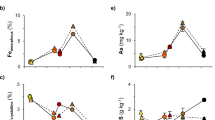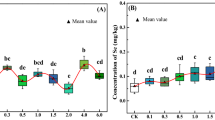Abstract
The scope of the work was to investigate the influence of selenate fertilisation and the addition of symbiotic fungi (mycorrhiza) to soil on selenium and selenium species concentrations in garlic. The selenium species were extracted from garlic cultivated in experimental plots by proteolytic enzymes, which ensured liberation of selenium species contained in peptides or proteins. Separate extractions using an aqueous solution of enzyme-deactivating hydroxylamine hydrochloride counteracted the possible degradation of labile selenium species by enzymes (such as alliinase) that occur naturally in garlic. The selenium content in garlic, which was analysed by ICP–MS, showed that addition of mycorrhiza to the natural soil increased the selenium uptake by garlic tenfold to 15 μg g−1 (dry mass). Fertilisation with selenate and addition of mycorrhiza strongly increased the selenium content in garlic to around one part per thousand. The parallel analysis of the sample extracts by cation exchange and reversed-phase HPLC with ICP–MS detection showed that γ-glutamyl-Se-methyl-selenocysteine amounted to 2/3, whereas methylselenocysteine, selenomethionine and selenate each amounted to a few percent of the total chromatographed selenium in all garlic samples. Se-allyl-selenocysteine and Se-propyl-selenocysteine, which are selenium analogues of biologically active sulfur-containing amino acids known to occur in garlic, were searched for but not detected in any of the extracts. The amendment of soil by mycorrhiza and/or by selenate increased the content of selenium but not the distribution of detected selenium species in garlic. Finally, the use of two-dimensional HPLC (size exclusion followed by reversed-phase) allowed the structural characterisation of γ-glutamyl-Se-methyl-selenocysteine and γ-glutamyl-Se-methyl-selenomethionine in isolated chromatographic fractions by quadrupole time-of-flight mass spectrometry.





Similar content being viewed by others
References
Clark LC, Combs GF, Turnbull BW, Slate EH, Chalkier DK, Chow J, Davis LS, Glover RA, Graham GF, Gross EG, Krongrad A, Lesher JL, Park HK, Sanders BB, Smith CL, Taylor JR (1996) J Am Med Assoc 276:1957–1963
Rayman MP (2000) Lancet 356:233–241
Larsen EH, Hansen M, Paulin H, Moesgaard S, Reid M, Rayman M (2004) J AOAC Int 87:225–232
Larsen EH, Andersen NL, Møller A, Petersen A., Mortensen GK, Petersen J (2002) Food Addit Contam 19:33–46
Hartikainen H (2005) J Trace Elem Med Biol 18:309–318
Cai X-J, Uden PC, Block E, Zhang X, Quimby B, Sullivan JJ (1994) J Agric Food Chem 42:2081–2084
Randle WM, Lancaster JE (2005) In: Rabinowitch HD, Currah L (eds) Allium crop science: recent advances. CABI Publications, Wallingford, UK, pp 329–356
Bergès R, Siess M-H, Arnault I, Auger J, Kahane R, Pinnert M-F, Vernevaut M-F, le Bon A-M (2004) Carcinogenesis 25:1953–1959
Fukushima S, Takada N, Hori T, Wanabuchi H (1997) J Cell Biochem Suppl 27:100–105
Ip C, Lisk DJ, Stoewsand GS (1992) Nutr Cancer 17:279–286
Ip C, Birringer M, Block E, Kontrebai M, Tyson J, Uden PC, Lisk D (2000) J Agric Food Chem 48:2062–2070
Finley JW, Davis CD, Feng Y (2000) Nutr Cancer 130:2384–2389
Davis CD, Zeng H, Finley JW (2002) J Nutr 132:307–309
Cai X-J, Block E, Uden PC, Zhang X, Quimby BD, Sullivan JJ (1995) J Agric Food Chem 43:1754–1757
Lawson LD (1996) In: Koch HP, Lawson LD (eds) Garlic: the science and therapeutic application of Allium sativum L and related species, 2nd edn. Williams & Wilkins, Baltimore, MD, pp 37–107
Ip C, Lisk DJ (1994) Carcinogenesis 15:573–576
Ip C, Lisk DJ (1994) Carcinogenesis 15:1881–1885
Block E, Birringer M, Jiang W, Nakahodo T, Thompson HJ, Toscano PJ, Uzar H, Zhang X, Zhu Z (2001) J Agric Food Chem 49:458–470
Vonderheide AP, Wrobel K, Kannamkumarath SS, B’Hymer C, Montes-Bayon M, Ponce de Leon C, Caruso JA (2002) J Agric Food Chem 50:5722–5728
Larsen EH, Hansen M, Fan T, Vahl M (2001) J Anal Atom Spectrom 16:1403–1408
Auger J, Yang W, Arnault I, Pannier F, Potin-Gautier M (2004) J Chromatogr A 1032:103–107
Kahakachchi C, Boakye HT, Uden PC, Tyson JF (2004) J Chromatogr A 1054:303–312
Goenante Infante H, Hearn R, Catterick T (2005) Anal Bioanal Chem 382:957–967
Goenante Infante H, O’Connor G, Rayman M, Wahlen R, Spallholz JE, Hearn R, Catterick T (2005) J Anal Atom Spectrom 20:864–870
Kotrebai M, Birringer M, Tyson JF, Block E, Uden PC (1999) Anal Comm 36:249–252
Kotrebai M, Birringer M, Tyson JF, Block E, Uden PC (2000) Analyst 125:71–78
McSheehy S, Yang W, Pannier F, Szpunar J, Lobinski R, Auger J, Potin-Gautier M (2000) Anal Chim Acta 421:147–153
Shah M, Kannamkumarath SS, Wuilloud JCA, Wuilloud RG, Caruso JA (2000) J Anal Atom Spectrom 19:381–386
Dumont E, Ogra Y, Vanhacke F, Suzuki KT, Cornelis R (2006) Anal Bioanal Chem 284:1196–1206
Larsen EH, Sloth J, Hansen M, Moesgaard S (2003) J Anal Atom Spectrom 18:310–316
Mosse B, Hayman DS (1971) New Phytol 70:29–34
Terry N, Zayed AM, de Souza MP, Tarun AS (2000) Annu Rev Plant Phys 51:401–432
Acknowledgements
The authors thank Dr. Laurent Ouerdane for his help with ESI–MS/MS experiments. The cultivation of garlic at PRI was part of SEAFOODplus, an integrated research project financially supported by the EU under FP6 (http://www.seafoodplus.org).
Author information
Authors and Affiliations
Corresponding author
Rights and permissions
About this article
Cite this article
Larsen, E.H., Lobinski, R., Burger-Meÿer, K. et al. Uptake and speciation of selenium in garlic cultivated in soil amended with symbiotic fungi (mycorrhiza) and selenate. Anal Bioanal Chem 385, 1098–1108 (2006). https://doi.org/10.1007/s00216-006-0535-x
Received:
Accepted:
Published:
Issue Date:
DOI: https://doi.org/10.1007/s00216-006-0535-x




